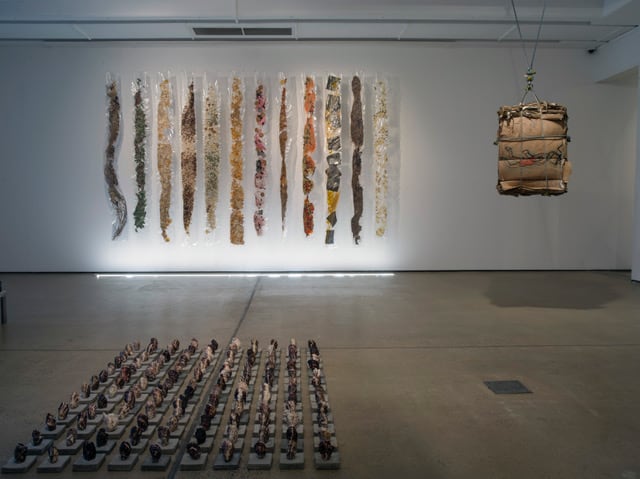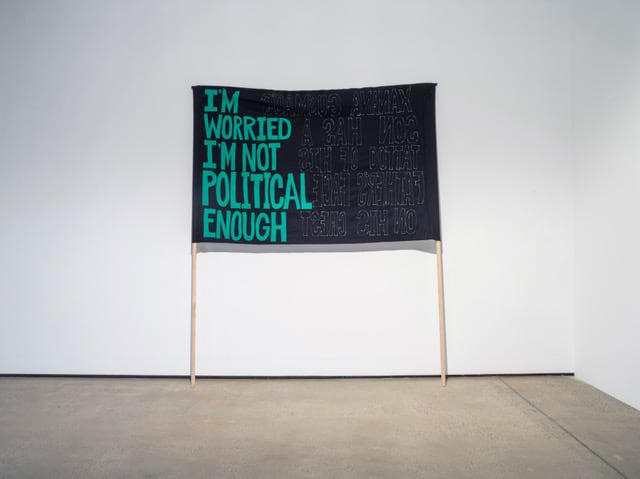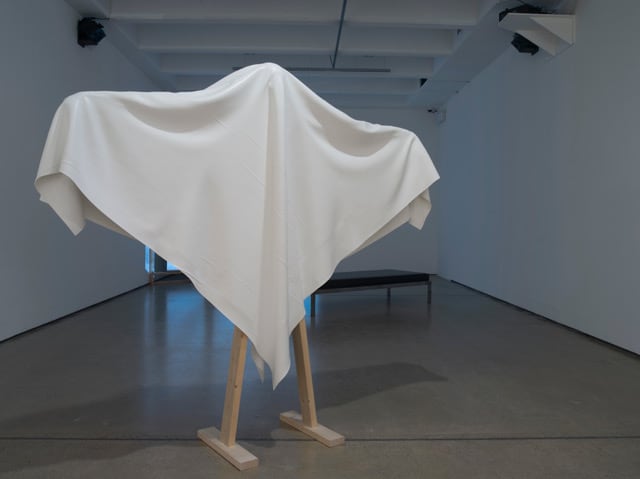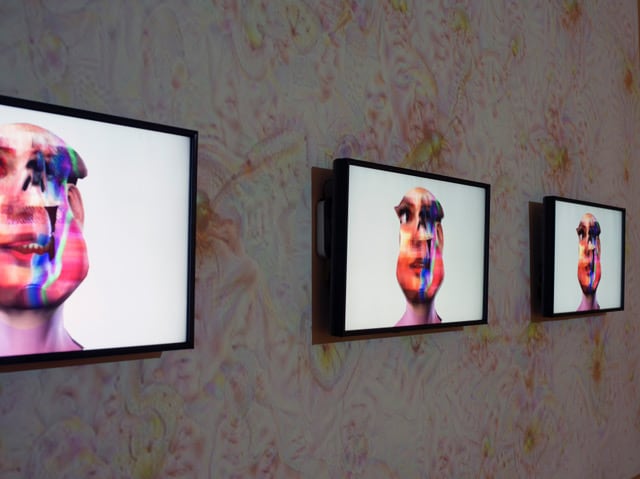



Artists: Zach Blas and Jemima Wyman, Megan Cope, Gabriella Mangano and Silvana Mangano, Archie Moore, Raquel Ormella, Keg de Souza and Tintin Wulia
Curator: Aileen Burns and Johan Lundh
In 1986 Peter Cripps, who was then Director of the Institute of Modern Art (IMA), curated Recession Art and Other Strategies.1 The exhibition hinged on the reality that Cripps and the other art-ists involved in the show were using easily accessible materials in an art world facing limited re-sources and shrinking budgets. Fast forward to 2017 and Material Politics picks up from where Cripps’ exhibition left off. Material Politics sees the continuation of artists working with an economy of means, while acknowledging art’s relationship to the capitalist sphere. This timely exhibition serves up musk sticks and artificial intelligence, alongside anxious activist banners.
Entering the gallery space, we are confronted by Raquel Ormella’s protest-style banner, taken from the series I’m worried this will become a slogan (1999–2009). The reversible banner leaning against the wall displays green text sewn onto black fabric. The words read, ‘I’m worried I’m not political enough’. A second statement, visible only as faint stitching, appears back-to-front on the banner. When deciphered, the statement on the back of the banner declares, ‘Xanana Gusmao’s son has a tattoo of his father's face on his chest’. Ormella’s initial self-reflexive statement suggests the artist is questioning her agency as an artist in relation to the political actions of the East Timorese politician and his son. The banner positions the viewer as the voice within the work — a technique presumably employed to evoke concern as a means for action. Humble fabrics of wool and felt form the banner, paying homage to the histories of women’s work and feminist art, and the traditions and strategies of protest marches and activism more broadly.
The linchpin in Jemima Wyman and Zach Blas’ four-channel video work im here to learn so :))))) (2017) is the artificial intelligence bot known as ‘Tay’ — the Twitter chatbot created by Microsoft in 2016. Tay was removed from the web after only sixteen hours when Twitter users ‘persuaded Tay to blithely use racial slurs and even outright call for genocide’.2 In Wyman and Blas’ work, three TV screens are positioned on the wall, a holographic patterned image projected overtop and calculated to miss the screens, falls in a perfect rectangle to frame the installation. Three sets of headphones lay on the bench in front of the work. The video footage on the televisions move in and out of synchronisation; the 3D modelled head of Tay appears on screen to discuss ‘life after Artificial Intelligence death’ before flicking to text of internet slang and screen capture imagery discussing pattern recognition. The robotic voice through the headphones mentions phrases such as data, algorithm, social media, gender, paranoia and anomaly detection. I’m initially surprised by the choice of music, Corona’s gay dance hit Rhythm of the Night (1993), playing intermittently throughout the work – ‘This is the rhythm of the night… The rhythm of my life… Oh yeah!’. It makes sense, though, combining these references to queer culture and social media. As a gender-queer person, I understand the importance of the internet as a location for queers to connect and dis-cuss minority politics.
Lining the far wall of the room is Keg de Souza’s work the earth affords them no food at all (2017). A range of food recognisably ‘Australian’, such as native finger limes and macadamia nuts, sit alongside processed items including Lamingtons and Chico Babies. Suspended like micro-galaxies, the rectangular cryovac bags filled with food items remind me of the edibles consumed at family celebrations and community gatherings. Tintin Wulia’s 172 Kilograms of Homes for Ate Manang (2017) consists of layers of cardboard, suspended in the space as a bale of utilitarian material. The cardboard found by Wulia in Hong Kong speaks of an informal recycling system organised by civil-ians, which sees the flattening and baling of cardboard boxes then sold to China for reasonable profit.3
Megan Cope examines processes tied to colonisation in Foundations II (2017). The artwork is com-prised of a grid of oyster shells, ten wide by fourteen deep, laid out on the floor and individually set into small squares of concrete. The two materials, which are intrinsically connected through colonisation, tell a story of transformation from ocean, to midden, to fire, lime and then mortar. Colonial construction relied on the quicklime extracted through the desecration of Aboriginal shell middens, displaying a total disregard towards the damage caused to Indigenous culture (in true capitalist fashion).4 The position of the work on the floor is appropriate, forcing us to consider the cement of the gallery floor on which we are standing. Noticeably, the outside of each shell pre-sents its own unique streaky pattern, but this individuality is soon lost in the uniformity of the work; the group of shells sit silently, patiently, awaiting their fate.
Leading into the next room is a work by Archie Moore, an artist whose practice is firmly grounded in Aboriginal politics. The newly commissioned work Bogeyman (2017) is a staunch figure with structural pine legs, waiting and watching as visitors enter through the door. The title of the work conjures up narratives of the imaginary monster used to frighten children into good behaviour. In this work, Moore displays his perfected painting technique of ‘acrylic on nothing’ (autonomous paintings created through a layering process – free of the support received by canvas or board) as a large white plastic sheet shrouding the spooky figure. This direct reference to the ghost aligns with events in which Indigenous Australians initially mistook white skinned colonial settlers as evil spirits invading the land. As I write this I wonder if mistook is the right word to use, as for many Indigenous people white settlers acted as evil spirits would.
The final work of the exhibition 39 Steps (2017) by Gabriella Mangano and Silvana Mangano, looks at the artists’ interest in the notion of limited means. The video takes a close look at the female form, its place in activist work and public politicised spaces. The video footage features choreog-raphy borrowed from a recent Women’s March in Melbourne ‘in which the body embodies the message.’5 The female troupe perform a range of actions and gestures with their bodies dancing in in and around significant architectural sites of Melbourne.
In a political climate where artists are not receiving fair pay (or any pay in some cases) for their work, it is no surprise that an institution such as the IMA is commissioning artists to create new political works contemplating the return to affordable materials.6 I am only surprised by how modestly sized the gallery space is for the exhibition – especially given the significance of the works on show. While it is fantastic for the IMA to support politically-minded Australian artists, I believe these artworks deserve to be given more exhibition space and could have filled the entire IMA.
What is made evident through this exhibition, and its echoes of the 1986 Cripps’ project, is the fact that contemporary artists are able to successfully adapt in the face of adversity and economic downturn. Throughout the exhibition there is a persistent ‘make something out of nothing’ attitude, highlighting the importance of commitment in trying times. Material Politics proves that being strapped for cash pushes adaptability, encourages community and resourcefulness. To be frank, it’s not often that I feel compelled to write a review, but there is something about seeing themes of decolonisation, nineties queer culture, community work and minority group resistance together, that warms my Gen-Y heart, and hopefully yours as well.
Lu Forsberg is an artist-researcher, writer and facilitator living on and working between the traditional lands of the Darug and Gundungurra People and the land of Gadigal People of the Eora Nation. Lu has received various awards and scholarships for their work and has exhibited at art spaces across Australia including the IMA, UNSW Galleries, QUT Art Museum, and Metro Arts.
